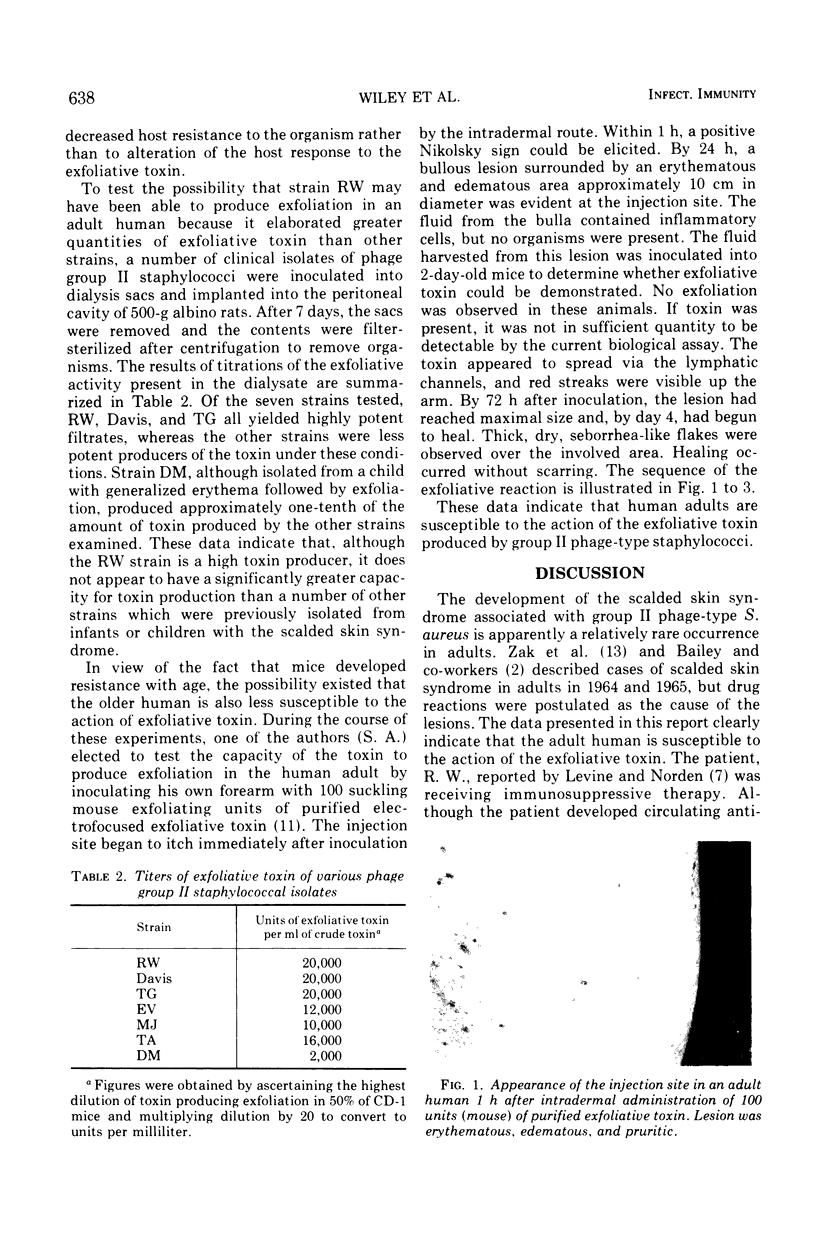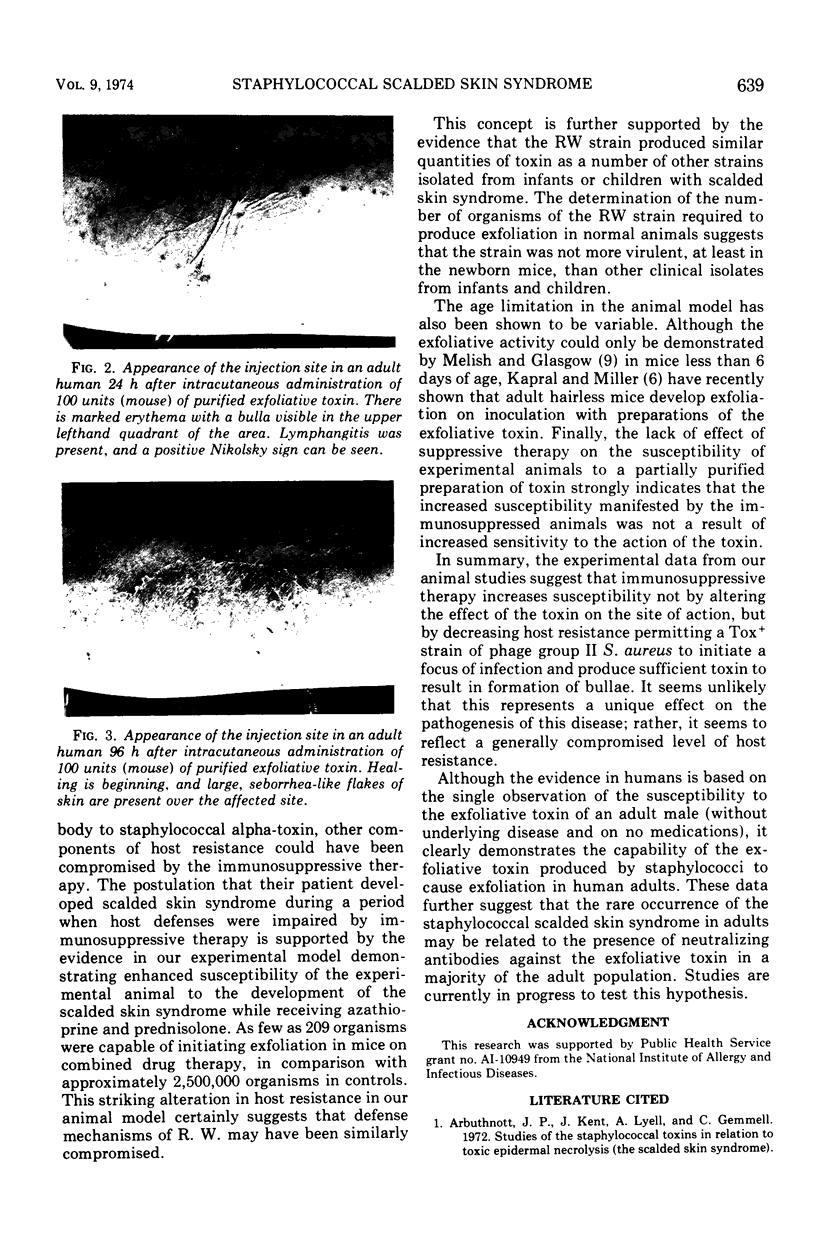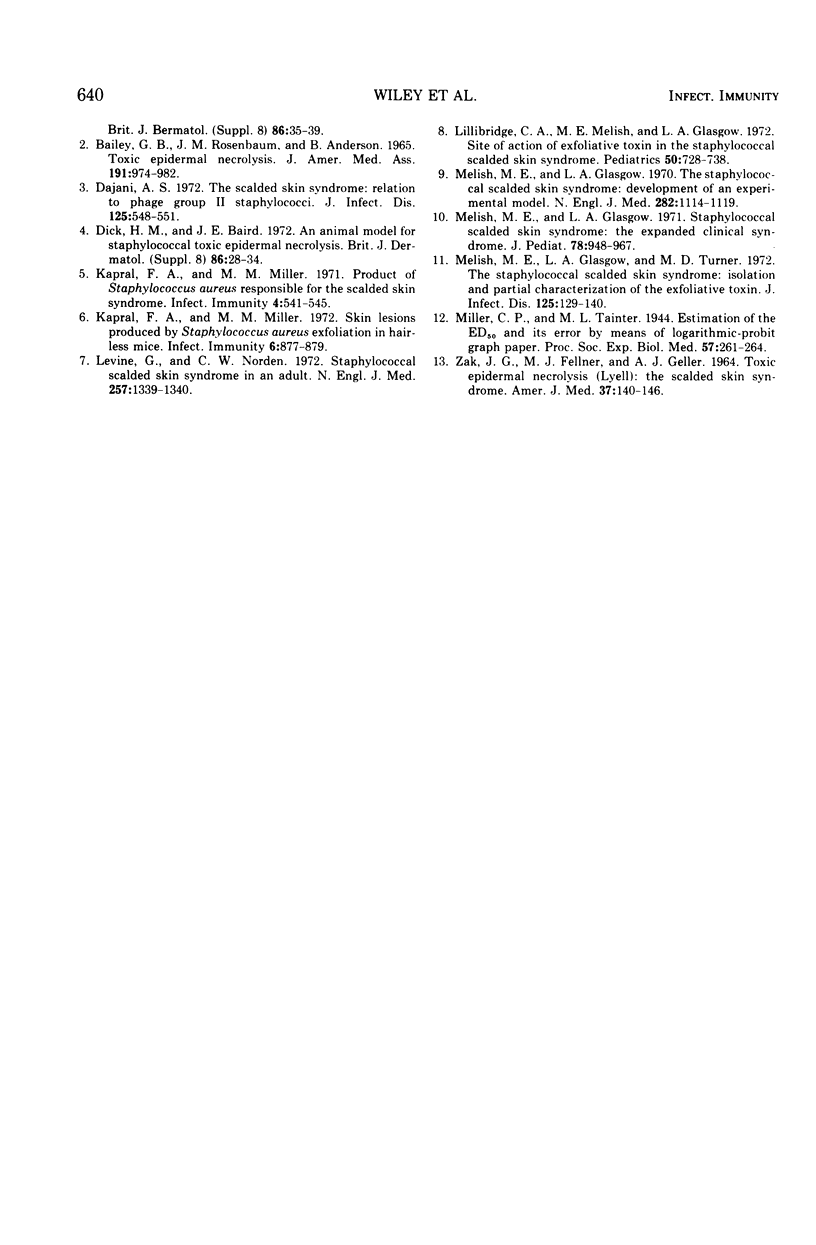Abstract
Staphylococcal scalded skin syndrome, associated with exfoliative toxin produced by phage group II Staphylococcus aureus, has recently been reported in an adult receiving immunosuppressive therapy. To determine the effect of immunosuppression on the development of the staphylococcal scalded skin syndrome, experimental animals were treated with prednisolone, azathioprine, or a combination of both drugs utilizing the clinical isolate from the adult with scalded skin syndrome. The mean lethal dose and mean exfoliating dose were identical and were 6,000-fold lower in animals receiving both drugs or azathioprine alone. The isolate was not more virulent and did not produce more toxin than other group II phage-type strains. Furthermore, immunosuppressive therapy failed to enhance the susceptibility of experimental animals to a purified preparation of toxin. Finally, purified exfoliative toxin was demonstrated to produce erythema, Nikolsky's sign, bullous formation, and flaking desquamation in a normal human adult. The results demonstrated the enhanced susceptibility of experimental animals receiving immunosuppressive therapy to the development of the staphylococcal scalded skin syndrome. They further showed that human adults are susceptible to the action of exfoliative toxin and suggested that, in the host with compromised defense mechanisms, toxin-producing strains may invade and initiate infection resulting in toxin production and exfoliation.
Full text
PDF




Images in this article
Selected References
These references are in PubMed. This may not be the complete list of references from this article.
- BAILEY G., ROSENBAUM J. M., ANDERSON B. TOXIC EPIDERMAL NECROLYSIS. JAMA. 1965 Mar 22;191:979–982. doi: 10.1001/jama.1965.03080120013003. [DOI] [PubMed] [Google Scholar]
- Dajani A. S. The scalded-skin syndrome: relation to phage-group II staphylococci. J Infect Dis. 1972 May;125(5):548–551. doi: 10.1093/infdis/125.5.548. [DOI] [PubMed] [Google Scholar]
- Kapral F. A., Miller M. M. Product of Staphylococcus aureus responsible for the scalded-skin syndrome. Infect Immun. 1971 Nov;4(5):541–545. doi: 10.1128/iai.4.5.541-545.1971. [DOI] [PMC free article] [PubMed] [Google Scholar]
- Kapral F. A., Miller M. M. Skin lesions produced by Staphylococcus aureus exfoliatin in hairless mice. Infect Immun. 1972 Nov;6(5):877–879. doi: 10.1128/iai.6.5.877-879.1972. [DOI] [PMC free article] [PubMed] [Google Scholar]
- Levine G., Norden C. W. Staphylococcal scalded-skin syndrome in an adult. N Engl J Med. 1972 Dec 28;287(26):1339–1340. doi: 10.1056/NEJM197212282872608. [DOI] [PubMed] [Google Scholar]
- Lillibridge C. B., Melish M. E., Glasgow L. A. Site of action of exfoliative toxin in the staphylococcal scaled-skin syndrome. Pediatrics. 1972 Nov;50(5):728–738. [PubMed] [Google Scholar]
- Melish M. E., Glasgow L. A. Staphylococcal scalded skin syndrome: the expanded clinical syndrome. J Pediatr. 1971 Jun;78(6):958–967. doi: 10.1016/s0022-3476(71)80425-0. [DOI] [PubMed] [Google Scholar]
- Melish M. E., Glasgow L. A. The staphylococcal scalded-skin syndrome. N Engl J Med. 1970 May 14;282(20):1114–1119. doi: 10.1056/NEJM197005142822002. [DOI] [PubMed] [Google Scholar]
- Melish M. E., Glasgow L. A., Turner M. D. The staphylococcal scalded-skin syndrome: isolation and partial characterization of the exfoliative toxin. J Infect Dis. 1972 Feb;125(2):129–140. doi: 10.1093/infdis/125.2.129. [DOI] [PubMed] [Google Scholar]
- ZAK F. G., FELLNER M. J., GELLER A. J. TOXIC EPIDERMAL NECROLYSIS (LYELL). THE SCALDED SKIN SYNDROME. Am J Med. 1964 Jul;37:140–146. doi: 10.1016/0002-9343(64)90218-9. [DOI] [PubMed] [Google Scholar]





